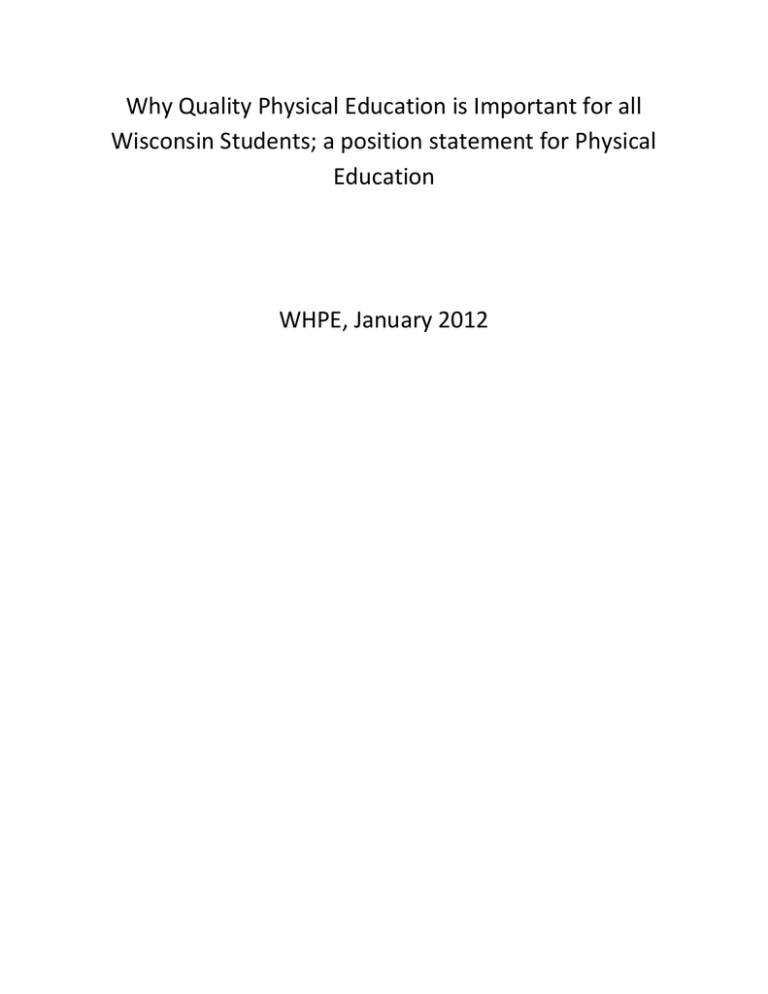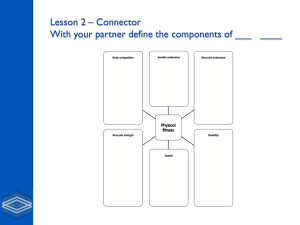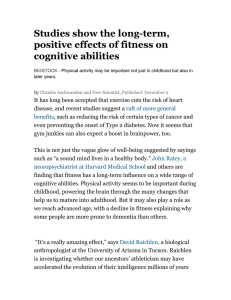WHPE PE Position Papers
advertisement

Why Quality Physical Education is Important for all Wisconsin Students; a position statement for Physical Education WHPE, January 2012 WHPE Position Statement on Physical Education The Benefits of a Quality Physical Education Program Physical education is an integral part of the total education of every child in Kindergarten through Grade 12. Quality physical education programs are needed to increase the physical competence, health-related fitness, self-responsibility and enjoyment of physical activity for all students so that they can be physically active for a lifetime. Physical education programs can only provide these benefits if they are well-planned and well-implemented. Improved Physical Fitness Improves children's muscular strength, flexibility, muscular endurance, body composition and cardiovascular endurance. Skill Development and Skill Appreciation Develops motor skills, which allow for safe, successful and satisfying participation in physical activities. Also provides an appreciation for what skilled movement entails. Regular, Healthful Physical Activity Provides a wide-range of developmentally appropriate activities for all children. Incorporates the principles of exercise(how, when, why and how often). Support of Other Subject Areas Reinforces knowledge learned across the curriculum. Serves as a lab for application of content in science, math and social studies. Self -Discipline Facilitates development of student responsibility for health and fitness. Improved Judgment Quality physical education can influence moral development. Students have the opportunity to assume leadership, cooperate with others; question actions and regulations and accept responsibility for their own behavior. Stress Reduction Physical activity becomes an outlet for releasing tension and anxiety, and facilitates emotional stability and resilience. Allows for more concentration in the classroom following Strengthened Peer Relationships Physical education can be a major force in helping children socialize with others successfully and provides opportunities to learn positive people skills. Especially during late childhood and adolescence, being able to participate in dances, games and sports is an important part of peer culture. Improved Self-confidence and Self-esteem Physical education instills a stronger sense of self-worth in children based on their mastery of skills and concepts in physical activity. They can become more confident, assertive, independent and selfcontrolled. Experience Setting Individual goals for personal enjoyment and achievement Gives children the opportunity to set and strive for personal, achievable goals. Subject Knowledge Gives students cognitive information on safety, biomechanics, exercise physiology, motivation, personal health and nutrition, Aids in Prevention of Obesity Helps build skills that support an active lifestyle. Improves Academic Performance Numerous peer reviewed studies in the last 10 years has shown a positive relationship between Physical Education, exercise and academic performance in K-12 students. WHPE Physical Education Position Statement Research from Brain Based Activities on physical activity and learning There is evidence that physical activity can impact student performance and academic learning. 1. Physical exercise has a definite impact on the frontal lobe of the brain, a primary area for concentration, planning and memory. 2. Being active promotes cell growth and regeneration, grows new brain cells and synaptic connections, it is like “Miraclegro for the Brain” (John Ratey) 3. Movement helps prepare the brain for learning by bringing more blood and glucose. 4. What makes us move is also what makes us think (John Ratey) 5. Exercise improves the neural connections in the brain through increased BDNF and other neural transmitters like dopamine and endorphins. BDNF exerts a fertilizer like growth effect on certain neurons in the brain. 6. Cross lateral movement organizes brain functions (Blaydes Madigan) 7. The brain is a muscle and to add new cells stress in the form of exercise must occur (Ratey) 8. The PE4Life program was shown to reduce disciplinary issues. (Ratey and PE4Life). 9. Studies have shown physical activity improves cognitive function in children. (Sibley, 2003) From Brain Rules, a book by John Medina comes the following paragraph from chapter 1, exercise boosts brain power. “Exercise Improves children. Physically fit children identify visual stimuili much faster than sedentary ones. They appear to concentrate better. Brain activation studies show that children and adolescents who are fit allocate more cognitive resources to a task and do so for longer periods of time. (p. 18) “Imaging studies have shown that exercise increases blood flow in the dentate gyrus area of the hippocampus, which is a center for memory formation. (p. 22)” “Because of the increases reliance on test scores for school survival, many districts are getting rid (or reducing) of physical education and recess. Given the powerful cognitive effects of physical activity, this makes no sense(Brain Rules, p 24)” At the U of Illinois, psychophysiologist Charles Hillman studied third and fifth graders and found a positive correlation between fitness and academics. Of the six areas that the Fitnessgram measures, two were particularly important to academic performance: BMI and aerobic fitness. The electroencephalogram (EEG) showed more activity in fit kids’ brains, indicating that more neurons involved were being recruited for a given task. The conclusion: better fitness equals better attention and better results. In the Naperville, IL school district, zero hour physical education classes led to increased test score in math and science as measured by the TIMSS, they were the highest scores in the country on math and were higher than some countries and were sixth in the science core. The only variables that appear to be different between Naperville and the other schools were the test results and the physical education programs. Other changes were noted, included reduced disciplinary problems and fewer suspensions. (Charleston Public Academy) WHPE Physical Education Position Statement The use of waivers, exemptions and substitutions for Physical Education It is the position of WHPE that physical education is an academic subject. WHPE believes that all K-12 students should take all required physical education courses and that no substitutions, waivers, or exemptions should be permitted. Also note that the WIAA has come out against the use of waivers for physical education. Consider the following questions if a school is proposing waivers for physical education: 1. Are athletics a right or a privilege regardless of a student’s ability? 2. What happens if the student breaks a code of conduct his/her senior year and that is the sport or activity for which the student seeks approval based on this statute? 3. Is a six to seven week golf team season equal to an 18-week varsity basketball season or to a semester of physical education? Time spent on the sport or approved physical activity is variable. 4. Are sports or activities where cuts occur preventing equal opportunity to all students that want to pursue this option? These may include swing choir, marching band or cheerleading. 5. Should sport participation approval only occur when it is at the varsity level or is any level agreeable? 6. Can the board approve of a sport or physical activity in the same year as the student takes a physical education course? It is possible that the student could finish his/her PE requirement by the sophomore year instead of the three year profession presently in law. 7. What happens if the student is injured during the sport or activity? 8. Should ROTC or club sports be included as a physical activity? 9. What happens if the coach kicks the student off the team during the season? 10. Should the board consider the licensure of the coach in the sport approval process? 11. Are items like exercise principles covered or addressed by the coach? 12. What about managers, are they exempt? 13. Who is responsible for providing the credit and providing accountability? What Does a Quality Physical Education Program Look like? WHPE believes a quality program in Physical Education has many observed characteristics to the administrator and building principal. They can be noted and recorded with the following checklist of quality indicators. A yes response indicates best professional practices. Y N The administration holds the program and staff accountable for meeting educational and state standards and values PE for its contributions to academic success. Y N A program that has similar class size and academic expectations as other subjects. Y N A current curriculum that meets Wisconsin model academic content standards with stated outcomes for each grade and unit. Y N Promotes a positive approach to lifetime participation in physical activities. Y N Promotes an awareness and cognitive understanding of the value and benefits of physical activity to overall personal health. Y N Provides teacher directed choices with a lesson focus and outcomes prior to the start of class, rather than deciding on the spur of the moment (Friday free day, which students shout loudest get the choice). Y N Well planned sequential lessons that have objectives for all domains of learning (psychomotor, affective, cognitive and health-related). Y N Delivers activities and lessons that address all 5 components of health related physical fitness; cardiovascular, muscular strength, muscular endurance, flexibility and body composition. Y N Makes assessment relevant, worthwhile and directly related to the learning of outcomes, uses multiple assessment tools and includes all domains of learning, rather than a single measure or skill test. Y N Formal and informal monitoring and assessment of personal fitness levels at regular intervals. Y N Compliments the school health program and the overall school wellness model, and provides instruction in the area of nutrition. Y N Opportunities for individualized goal setting and reflection. Y N Students are graded on achievement of educational goals and outcomes, rather than dressing out, effort and participation, or wearing a uniform. Y N The physical education teacher follow best practices of instruction. Y N The chosen activities and equipment are age and developmentally appropriate. Y N The teachers regularly participate in professional development opportunities. WHPE Position Statement of Physical Education Commonly Asked Questions and Talking Points. 1. Why are certified physical teachers needed? *Physical education is an academic subject that meets educational outcomes. *Certified physical educators are trained to assess the fitness level of all students and prescribe appropriate physical activities. *Physical educators provide age appropriate lessons and tasks. *Physical educators provide programs that meet academic and content standards. *Physical educators provide a sequential curriculum, instruction, and assessment. 2. Why do athletes need physical education? Sports Physical Education Exclusive by nature Inclusive by nature Focus on winning today Focus on learning for life Skill based Knowledge and skill based Sport specific Lifetime activities and healthy lifestyles Competitive Cooperative A privilege for a few A right for all students Limited scope of fitness, eg. shotput All 5 components of health related fitness 3. Why not include activities like dodge ball in physical education? *Any activity that uses a student as a target is inherently unsafe and provides opportunities for bullying. *Little if any learning takes place therefore a certified physical education teacher is not needed. *Elimination games are inappropriate because the least skilled students are eliminated first. 4. Are there guidelines for physical education and where can I find them? *Wisconsin’s Model Academic Standards for Physical Education are aligned with the National Standards and can be accessed at www.whpe.us *The National Association for Sport and Physical Education has developed several valuable position papers and can also be accessed through www.whpe.us 5. Does Wisconsin have mandates and where can I find them? *The Department of Public Instruction’s Web site lists administrative rules for Physical Education in Wisconsin. Standard J. 1. 2. 3. 4. 5. Comprehensive curriculum and program of instruction for all pupils. K-6 – Three times per week minimum. In a middle school format, grade 6 weekly minimum. K-6 by or under the direction of a licensed physical education teacher. Senior high schools –One year may be optional to pupils. Standard K. 1. K-12 Sequential curriculum plan. Standard L. 1. K-4 Regular Instruction—Each week for an entire school year to meet the plan required in (K) (Note: See J—K-6 three times per week) 2. 5-8 regular Instruction—Each week for the entire school year to meet the plan required in (K) 3. 9-12 – Access for pupils each year. Standard P. 1. In grades 9-12 at least 1.5 credits of physical education incorporating effects of exercise, health-related fitness, and lifetime activities. 2. Credits must be earned over three separate years. 6. Can athletes be excused from Physical Education? Wisconsin Act 105, 118.33 (1)(e) A school Board may allow a pupil who participates in sports or in another organized physical activity, as determined by the school board, to complete an additional 0.5 credit in English, social studies, mathematics, science, or health education in lieu o 0.5 credit in physical education.




